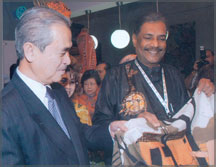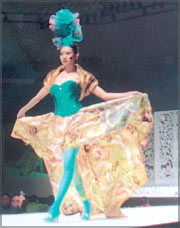Keeping a traditional craft alive
|
|
|
Buddhi Keerthisena, a special invitee to the event who was also the former Chairman of the National Crafts Council, thinks that batiks, which once played a major role in the craft sector can be re-developed to its old standard with state backing.
The art of batik has been a major player, especially in Asia among crafts that has been used to decorate garments, both for men and women. Today it has reached the grounds of high fashion markets the world over and Malaysia is a front-runner in this aspect.
We here in Sri Lanka too had batiks playing an important role, especially as an export commodity. That was in the early 70s and amongst the pioneers in leading that export market was Buddhi Keerthisena who exported to a large part of Europe and also to many Scandinavian countries.
Malaysia which hosted this grand convention invited Buddhi Keerthisena to participate in the convention and to address the large gathering that was present. The event was organised by the Batik Guild of Malaysia in collaboration with Yayasan Budi Penyayang and the Ministry of Cultural Affairs in Malaysia.
|
|
Buddhi Keerthisena told the Daily News that there were many things that was very inspiring about how the state treated the craft, the way it was promoted and the decisions that were made to preserve it as a national craft and promote it among Malaysians as a symbol of pride.
"Once a week, everybody including the heads of state clad themselves in Batik," said Keerthisena, further stating that the royal family and the Prime Minister and other VIPs promote the craft by patronising it at a high level and giving priority to it at state functions and other important events.
On Saturdays when it is a half working day it is a common sight to watch all public servants clad in batiks.
At the convention many of the participants got the opportunity to discuss and exchange ideas on the subject.
|
|
Keerthisena in his speech stressed the need to sustain the batik industry in Sri Lanka, which was once a major foreign exchange earner and also the history of the craft, its rapid development and its decline in his country.
He further stressed the need to save the craft from plunging into a cheap commodity in the hands of wholesalers, who use inferior raw material to produce the craft and market it at a cheap rate.
According to Keerthisena it is an important aspect in the production of batik to sustain its high quality standards that once prevailed. "This is important, if we are to revive batik from its present plight here in Sri Lanka," he added.
Professor Jayadeva Tilakasiri who was also at the event, promoting our local arts and crafts, delivered a speech stating the high potential these crafts contain as export products, with special emphasis on batiks and highlighted the fact how this potential remains un-utilised for too long.
|
|
Speakers from India, Indonesia, China, Australia, United Kingdom, United States also addressed the large gathering that was present at this event which was held for four days.
On the suggestion of the Chairperson of the convention, Puan Leela Mohd Ali, 'The World Batik Council' was formed. Sri Lanka too is playing an important role in the council with Buddhi Keerthisena being felicitated as one of its founder members.
In the early 70s the batik industry here thrived at a large scale and there was a big export market for batik wall hangings and garments worldwide.
But with the ethnic crisis as with all other trades the batik industry too suffered a major pitfall.
As a result of these events batik manufacturers began to explore the possibilities of marketing the product inland.
This automatically got many people started off into producing batiks for the local market. But a lot of adjustments had to come in to keep the local market afloat, pricing was one big factor.
|
|
To keep the price low inferior chemicals and dyes began to flood the market and the prices became very competitive for somebody of Keerthisena's calibre to keep abreast with.
As a man that owned and operated a factory with over 700 workers and exporting the best quality batiks to Europe and Scandinavia it was below his dignity to produce an inferior product.
Today his daughter, who is a designer qualified in the UK and worked for the apparel industry here in Sri Lanka while working also as a visiting lecturer at the University of Moratuwa, has given up her job in the apparel industry and spends all her time producing batiks because she too thinks that there is yet a large scope for the technique to catch on again.
"We must train young people to enter the field because there is a lot of employment opportunities in it," says Keerthisena stressing that producers should be given concessions as in the past to be able to buy raw materials of high quality so that a standard of high quality in the finished product can be maintained.
He also added that his visit and participation in the Kuala Lampur International Batik Convention was an eye-opener as to how those countries work towards making their indigenous crafts popular both at home and abroad.
Keerthisena, one of Sri Lanka's pioneer batik manufacturers, feels that it is time that we made a lot of effort to turn around the image of all our crafts and made it a national occupation for our people to feel and patronise our products in a larger scale making it beneficial for the development of our country.
..................................








